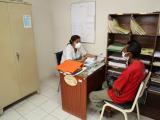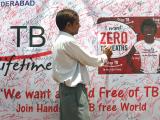Mar 18, 2010 (CIDRAP News) In some parts of the world as many as 25% of people who contract tuberculosis (TB) end up with the multidrug-resistant variety (MDR-TB), but recent experience shows it is possible to control the disease even in hard-hit areas, the World Health Organization (WHO) said in a report released today.
The WHO estimates that 440,000 people had MDR-TB in 2008 and that 150,000 of them died, with close to half of the cases in China and India. The agency says about 3.6% of all TB cases are MDR-TB, which is similar to what it estimated in a report 2 years ago.
The WHO report, released several days early because a news embargo was broken, came as the US Centers for Disease Control and Prevention (CDC) said that the rate of all TB cases in the United States in 2009 was down by a surprising 11.4%, the biggest decrease on record. The reasons for the big drop are unclear, the agency said
MDR-TB is caused by bacteria that are resistant to the most effective TB drugs, isoniazid and rifampicin, the report notes. People can contract the disease from others, or the resistance may develop in the course of treatment.
High MDR-TB rates in Russia
Russia has reported some of the worst rates of MDR-TB, which accounted for 28% of new TB cases in one northwestern region, the highest ever reported anywhere, the WHO said. The previous record was 22% in Baku City, Azerbaijan, in 2007. Twelve countries, all in Eastern Europe or Central Asia, have reported MDR-TB rates of 6% or more among new TB cases.
An encouraging sign, however, is that two Russian regions, Orel and Tomsk, "have achieved a remarkable decline in MDR-TB in about five years," the WHO said in a press release. "These regions join two countriesEstonia and Latviawhich have reversed rising high rates of MDR-TB, ultimately achieving a decline." The United States and Hong Kong also have achieved "sustained successes" in battling the disease, the release said.
"New findings presented in this report give reason to be cautiously optimistic that drug resistant TB can be controlled," the summary of the 71-page document states.
In China, the first nationwide drug resistance survey showed that MDR-TB makes up 5.7% of new TB cases and 25.6% of previously treated cases, the WHO reports. The survey confirms that about 100,000 cases of MDR-TB are emerging in China annually.
Treatment success at 60%
As for treatment, 60% of 4,500 MDR-TB patients whose cases were well documented were treated successfully, the report says, adding that treatment success remains low because of a "high frequency of death, default, and treatment failure," along with many cases without reported definitive outcomes. Moreover, only an estimated 7% of all MDR-TB patients are diagnosed, the agency noted.
In other observations, the WHO said it "has not been possible to conclude whether an overall association between MDR-TB and HIV epidemics exists," because only 11 countries and three territories have provided adequate surveillance data on the issue. But TB patients living with HIV in Estonia, Latvia, Lithuania, and Moldova seem to have a greater risk of harboring MDR-TB strains.
The report also offers some findings on a less common but even harder-to-treat form of TB: extensively drug-resistant TB (XDR-TB), which resists not only the two leading TB drugs but also fluoroquinolones and second-line injectable drugs. Among 46 countries that had continuous surveillance or representative surveys of second-line drug resistance, 5.4% of patients with MDR-TB were found to have XDR-TB. Eight countriessix of them in Eastern Europe and Central Asiareported XDR-TB in more than 10% of MDR-TB cases.
"No official estimates have been made on the number of XDR-TB cases, but there may be around 25,000 a year with most cases fatal," the WHO said in the press release.
Drop in US TB rate unexplained
In the United States, 11,540 TB cases were reported in 2009, for a rate of 3.8 cases per 100,000 population, the CDC said in Morbidity and Mortality Weekly Report today. That signals a surprising drop of 11.4% from the 2008 rate of 4.2 cases per 100,000.
"The 2009 rate showed the greatest single-year decrease ever recorded and was the lowest recorded rate since national TB surveillance began in 1953," the CDC said. Cases and rates declined in both foreign-born people and US natives, though rates in foreign-born people and minorities continued to be disproportionately high.
The CDC and the National Tuberculosis Controllers Association are investigating whether the decrease is real or results from underdiagnosis, underreporting, or some other factor, the report says. It says the decline might have resulted, in part, from reduced immigration and an increase in the return of recent immigrants to their native countries.
The report notes that the data are provisional and subject to change until the CDC's final TB surveillance summary is issued in the fall.
See also:
Mar 18 WHO press release
http://www.who.int/mediacentre/news/releases/2010/drug_resistant_tb_20100318/en/index.html
Full text of WHO MDR-TB report
http://whqlibdoc.who.int/publications/2010/9789241599191_eng.pdf
CDC. Decrease in reported tuberculosis casesUnited States, 2009. MMWR 2009 Mar 19;59(10):289-94 [Full text]



















